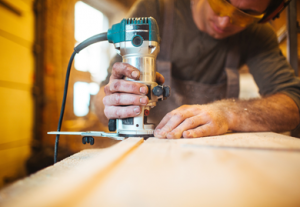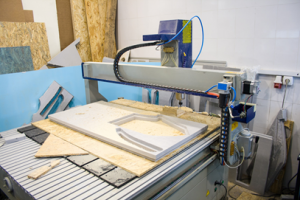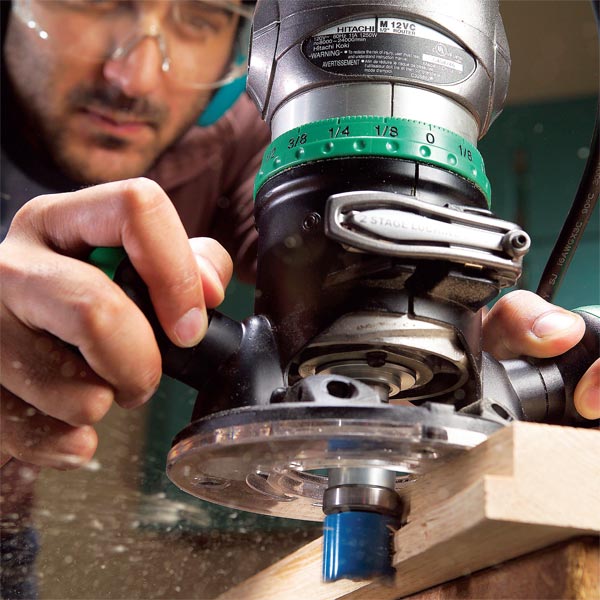When you’re completely new to woodworking, you might initially think that all you’ll need for your chosen weekend hobby is a hand saw to cut your wood and some sandpaper to smoothen your finished product. While both of them are essential to get started with woodworking, you’ll only go so far as to make rigidly square or rectangular pieces at best. By looking at any wooden table in your house that’s got rounded corners or a picture frame hanging on the wall with a distinctly shaped profile, you’ll notice that those couldn’t have been made using only a hand saw as doing so would be practically impossible.
John from cutmywood.co.uk said “CNC routers are great for those who don’t want to get as hands on and it removes a huge element of human error especially if you’re making products to dimension.”
What Are Routers and How Do They Work?
 Those rounded corners and shaped profiles that every wooden object in your house has, have been made using a power tool known as a router.
Those rounded corners and shaped profiles that every wooden object in your house has, have been made using a power tool known as a router.
- Aside from using it to make rounded corners and profiles, a router can also be used to cut U or L-shaped grooves onto wood so that you can join two blocks together in a less awkward and more aesthetically pleasing manner.
- You can also use your router to cut raised or etched patterns onto wood that’s more difficult to do using a chisel and hammer.
- A router comes with various bits that are almost similar to those that you’re using for your electric drill – that is, if you’ve got one as part of your arsenal of woodworking tools. The difference is that drill bits are for making holes whereas router ones are for cutting onto wood.
- Compared to carving wood with a chisel and hammer, using a router would only require you to plug the said power tool into the nearest electrical outlet in your shed and press the On button. The router’s motor would then spin your chosen bit at a very high speed.
What Are the Three Types of Routers?
Buying your first-ever router can be challenging with several options and brands available. To make your router buying experience easier for you, here are the three types of routers that you should know about:
1. Handheld router
Again, you might be absolutely new to the world of woodworking and wondering at the same time how you can justify spending your hard-earned money on a power tool like a router.
- Every person who has taken an initially passive interest in woodworking has started with using a handheld router which is the most basic type.
- Handheld routers have two subtypes, namely fixed and plunge base.
- Out of the two subtypes of handheld routers mentioned above, the fixed base one is the most commonly used – though you’re limited to cutting corners, profiles, grooves, and patterns onto the edges of your wood.
- In case you want to cut a profile, groove, or pattern onto the surface of your wood itself, you’ll want to use a plunge base router instead.
- An advantage of using a handheld router for your woodworking projects is that you can move the power tool around which makes it somewhat like a motorized chisel and hammer in one.
2. Table router
If you’ve got shaky hands, you shouldn’t get yourself a handheld router in case you suddenly lose your grip and the entire power tool itself flies in your direction. Thus, you should consider buying yourself a router table where you can screw your handheld router upside down into place to turn it into a table router.
3. CNC router
 If you’ve already become skilled at using either a handheld or table router, you’ll want to move to the next level of woodcutting by getting yourself one that’s of the CNC – or computer numerical control – type.
If you’ve already become skilled at using either a handheld or table router, you’ll want to move to the next level of woodcutting by getting yourself one that’s of the CNC – or computer numerical control – type.
- Trying to cut very complex patterns and reliefs onto wood using either a handheld or table router can get very difficult if not entirely undoable.
- With a CNC router – like the ones from Cancam, you can simply start working on any design that you want to commit to using a computer-aided design and manufacturing software allowing the entire machine do the woodcarving work for you.
Woodworking may still be an underrated weekend hobby, most especially given that turning blocks of wood into intricately designed masterpieces isn’t easy. Fortunately, woodworking is making a bit of a comeback, thanks to those in their late 20’s to early 30’s who have decided to venture into a pursuit that finds them using their hands more while unleashing their inner creativity at the same time. As you may be one of those younger people who have recently gotten into woodworking, you’ll want to learn more about one of the most versatile power tools that you’ll find yourself using a lot which is the router.
Steve Hansen
 Steve Hansen is currently contributing for CANCAM, and he aims to apply his artistic vigor and interests in writing make his pieces not just informative but entertaining as well. His knack for research paves way to well-informed pieces that are sure to satisfy the curiosity of his readers.
Steve Hansen is currently contributing for CANCAM, and he aims to apply his artistic vigor and interests in writing make his pieces not just informative but entertaining as well. His knack for research paves way to well-informed pieces that are sure to satisfy the curiosity of his readers.

